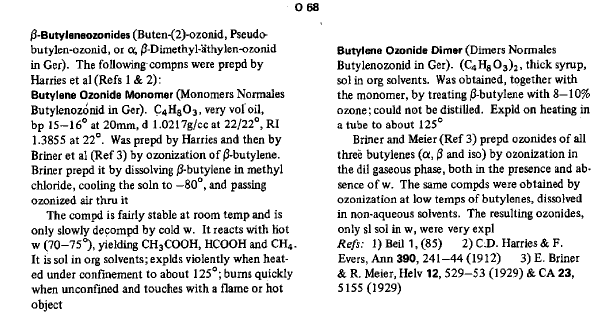Formatik
National Hazard
   
Posts: 927
Registered: 25-3-2008
Member Is Offline
Mood: equilibrium
|
|
Ozonides
This is a thread dedicated to organic and inorganic ozonides. Generally, organic ozonides are unstable, highly reactive, and some very powerful
explosives. They are made by bubbling ozone (usually ozone containing air) into the hydrocarbon alone or the same solubilized in an inert solvent like
CH2Cl2, CHCl3, CCl4, etc. usually at cold temperatures, ozonides like ozobenzene take many tireless hours to form. Moisture destroys them or causes
violent reaction. The organic ozonides are discussed a bit in PATR O66-73. In the forum, ozobenzene was briefly mentioned here, and ozonapthalene here. Though there are a few which don't seem that unstable, like the butylene ozonides.

|
|
|
Formatik
National Hazard
   
Posts: 927
Registered: 25-3-2008
Member Is Offline
Mood: equilibrium
|
|
Potassium ozonide (KO3) is mentioned in Ber. 35, [1902] 3038 by Bayer and Villiger and described as an orange-brown substance, made by action of ozone
onto powdered dry KOH. The addition of water causes to decolorize liberating gases. If ozone is led into a 40% solution of KOH which is in a cooling
mixture, the same intense orange-brown color results, but disappears as soon as it is removed from the cooling mixture. JACS 73 [1951] 79 reports CsO3
or KO3 reacting with water or aq acids is violent liberating O2 and flashes of light. Its crystall structure was described in this paper, who also mention that water vapor decomposes it partly to form KOH and KO2, to prevent decomposition in their analysis they were working at
-35º. Römpps Chemie Lexikon, 7 Aufl., Bd. III, 1701 mentions K forms a red potassium trioxide (K2O3), as well as the potassium ozonide by action of
O3 on K2O or KOH. There are a few webpages hinting KO3 itself could be explosive.
|
|
|
Taoiseach
Hazard to Others
  
Posts: 241
Registered: 16-3-2008
Member Is Offline
Mood: No Mood
|
|
Check this out:
http://ozonatedoliveoil.com/
http://www.journalarchive.jst.go.jp/jnlpdf.php?cdjournal=bcs...
Ordinary Olive oil saturated with ozone until it forms a thick paste - I guess it must be full of peroxides, which explains why it is useful for
treating acne and skin infections (think benzoyl peroxide!) I wonder if this stuff is energetic too.
Ozonides of other unsaturated oils:
http://www.freepatentsonline.com/4591602.html
Styrene ozonide:
http://www.journalarchive.jst.go.jp/jnlpdf.php?cdjournal=bcs...
"petroleum ozonide":
http://www3.interscience.wiley.com/cgi-bin/fulltext/11234038...
More interesting links:
http://www.orgsyn.org/orgsyn/prep.asp?prep=cv3p0673
http://www.fkf.mpg.de/jansen/p150/english/ozonides.html
[Edited on 22-11-2008 by Taoiseach]
[Edited on 22-11-2008 by Taoiseach]
|
|
|
Taoiseach
Hazard to Others
  
Posts: 241
Registered: 16-3-2008
Member Is Offline
Mood: No Mood
|
|
NaO3 stable at room temp is claimed to be prepared by passing O3 over dry NaOH:
http://ntrs.nasa.gov/archive/nasa/casi.ntrs.nasa.gov/1963000...
|
|
|
Formatik
National Hazard
   
Posts: 927
Registered: 25-3-2008
Member Is Offline
Mood: equilibrium
|
|
Thanks for the links, especially the last one. I had some difficulty finding decent data on the inorganic ozonides.
Leading ozonized air over solid KOH for a few minutes at room temperature forms a light orange layer which disappears once the O3-air is removed. Like
that pdf states they used cold temperatures to form it from this reaction, -10 to -15º. This reaction also forms water: 2 KOH + 5 O3 = 2 KO3 + 5 O2 +
H2O, so no wonder KO3 is easily destroyed and they used liquid NH3 to extract it.
The wiki page on O3 states NaO3 can't be made from NaOH, according to that pdf, that's wrong.
I have doubts about the ozonides of olive oil possessing significant energetic properties since the -O-O-O- bond might be diluted.
[Edited on 22-11-2008 by Formatik]
|
|
|